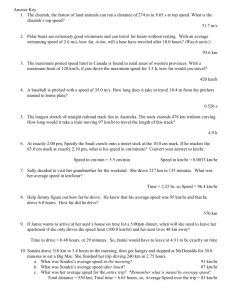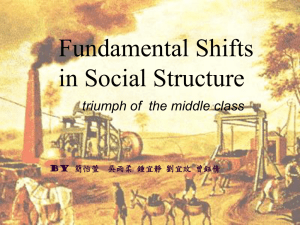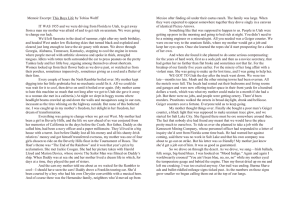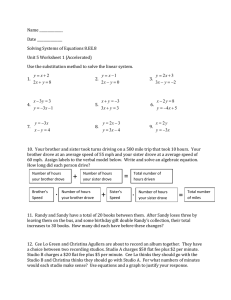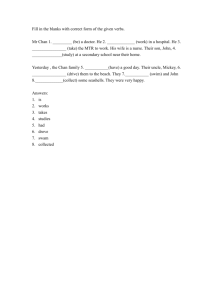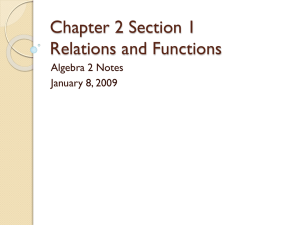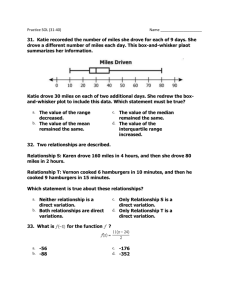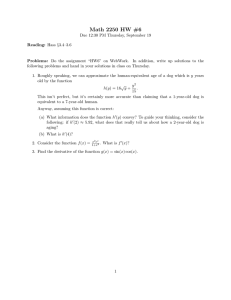Document 13542929
advertisement
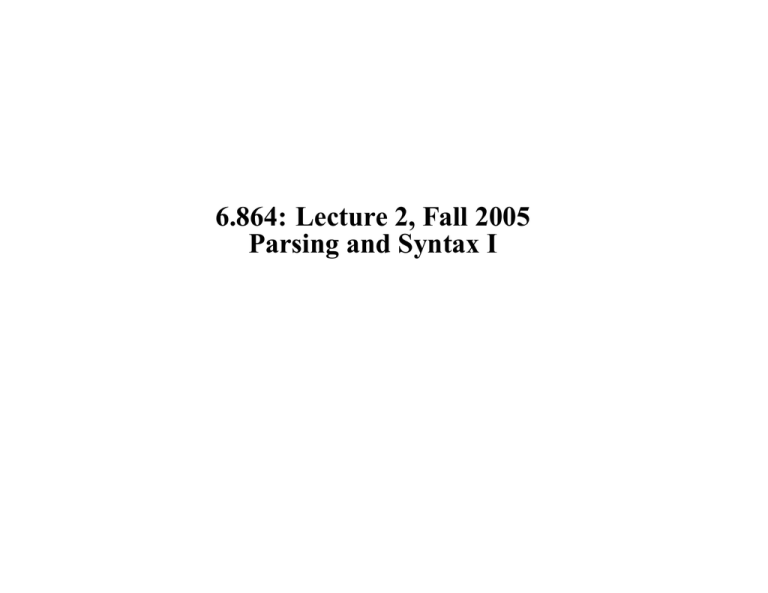
6.864: Lecture 2, Fall 2005
Parsing and Syntax I
Overview
• An introduction to the parsing problem
• Context free grammars
• A brief(!) sketch of the syntax of English
• Examples of ambiguous structures
• PCFGs, their formal properties, and useful algorithms
• Weaknesses of PCFGs
Parsing (Syntactic Structure)
INPUT:
Boeing is located in Seattle.
OUTPUT:
S
VP
NP
N
V
Boeing
is
VP
PP
V
located
P
NP
in
N
Seattle
Data for Parsing Experiments
• Penn WSJ Treebank = 50,000 sentences with associated trees
• Usual set-up: 40,000 training sentences, 2400 test sentences
An example tree:
TOP
S
VP
NP
NNP
NNPS
VBD
PP
NP
NP
CD
ADVP
PP
NN
IN
IN
PRP$
QP
$
CD
NP
PP
NP
RB
NP
JJ
NN
CC
JJ
NN
NNS
NP
IN
SBAR
NP
CD PUNC,
NNP PUNC,
WHADVP
S
VP
NP
WRB
DT
NN
NP
VBZ
NNS PUNC.
QP
RB
Canadian Utilities
had
1988
revenue of
C$
1.16
billion ,
mainly
from
its
natural gas
and
electric utility
businessesin
Alberta ,
where
the
company serves
about
CD
800,000 customers .
Canadian Utilities had 1988 revenue of C$ 1.16 billion , mainly from its
natural gas and electric utility businesses in Alberta , where the company
serves about 800,000 customers .
The Information Conveyed by Parse Trees
1) Part of speech for each word
(N = noun, V = verb, D = determiner)
S
VP
NP
D
N
the burglar
NP
V
robbed
D
the
N
apartment
2) Phrases
S
VP
NP
DT
N
V
the
burglar
robbed
NP
DT
the
N
apartment
Noun Phrases (NP): “the burglar”, “the apartment”
Verb Phrases (VP): “robbed the apartment”
Sentences (S):
“the burglar robbed the apartment”
3) Useful Relationships
S
NP
VP
subject
V
verb
S
VP
NP
DT
N
V
the
burglar
robbed
∪ “the burglar” is the subject of “robbed”
NP
DT
N
the
apartment
An Example Application: Machine Translation
• English word order is
• Japanese word order is
subject – verb – object
subject – object – verb
English:
Japanese:
IBM bought Lotus
IBM Lotus bought
English:
Japanese:
Sources said that IBM bought Lotus yesterday
Sources yesterday IBM Lotus bought that said
Syntax and Compositional Semantics
S:bought(IBM, Lotus)
NP:IBM
IBM
VP:�y bought(y, Lotus)
V:�x, y bought(y, x)
NP:Lotus
bought
Lotus
• Each syntactic non-terminal now has an associated semantic
expression
• (We’ll see more of this later in the course)
Context-Free Grammars
[Hopcroft and Ullman 1979]
A context free grammar G = (N, �, R, S) where:
• N is a set of non-terminal symbols
• � is a set of terminal symbols
• R is a set of rules of the form X ∈ Y1 Y2 . . . Yn
for n � 0, X � N , Yi � (N � �)
• S � N is a distinguished start symbol
A Context-Free Grammar for English
N = {S, NP, VP, PP, DT, Vi, Vt, NN, IN}
S = S
� = {sleeps, saw, man, woman, telescope, the, with, in}
Vi
∪ sleeps
R =
S
∪ NP VP
Vt ∪ saw
VP ∪ Vi
NN ∪ man
VP ∪ Vt NP
NN ∪ woman
VP ∪ VP PP
NN ∪ telescope
NP ∪ DT NN
DT ∪ the
NP ∪ NP PP
IN ∪ with
PP ∪ IN NP
IN ∪ in
Note: S=sentence, VP=verb phrase, NP=noun phrase, PP=prepositional
phrase, DT=determiner, Vi=intransitive verb, Vt=transitive verb, NN=noun,
IN=preposition
Left-Most Derivations
A left-most derivation is a sequence of strings s1 . . . sn , where
• s1 = S, the start symbol
• sn � �� , i.e. sn is made up of terminal symbols only
• Each si for i = 2 . . . n is derived from si−1 by picking the left­
most non-terminal X in si−1 and replacing it by some � where
X ∈ � is a rule in R
For example: [S], [NP VP], [D N VP], [the N VP], [the man VP],
[the man Vi], [the man sleeps]
Representation of a derivation as a tree:
S
VP
NP
D
N
Vi
the
man
sleeps
DERIVATION
S
NP VP
DT N VP
the N VP
the dog VP
the dog VB
the dog laughs
RULES USED
S � NP VP
NP � DT N
DT � the
N � dog
VP � VB
VB � laughs
DERIVATION
S
NP VP
DT N VP
the N VP
the dog VP
the dog VB
the dog laughs
RULES USED
S � NP VP
NP � DT N
DT � the
N � dog
VP � VB
VB � laughs
DERIVATION
S
NP VP
DT N VP
the N VP
the dog VP
the dog VB
the dog laughs
RULES USED
S � NP VP
NP � DT N
DT � the
N � dog
VP � VB
VB � laughs
DERIVATION
S
NP VP
DT N VP
the N VP
the dog VP
the dog VB
the dog laughs
RULES USED
S � NP VP
NP � DT N
DT � the
N � dog
VP � VB
VB � laughs
DERIVATION
S
NP VP
DT N VP
the N VP
the dog VP
the dog VB
the dog laughs
RULES USED
S � NP VP
NP � DT N
DT � the
N � dog
VP � VB
VB � laughs
DERIVATION
S
NP VP
DT N VP
the N VP
the dog VP
the dog VB
the dog laughs
RULES USED
S � NP VP
NP � DT N
DT � the
N � dog
VP � VB
VB � laughs
DERIVATION
S
NP VP
DT N VP
the N VP
the dog VP
the dog VB
the dog laughs
RULES USED
S � NP VP
NP � DT N
DT � the
N � dog
VP � VB
VB � laughs
S
VP
NP
DT
N
the
dog
VB
laughs
Properties of CFGs
• A CFG defines a set of possible derivations
• A string s � �� is in the language defined by the CFG if there
is at least one derivation which yields s
• Each string in the language generated by the CFG may have
more than one derivation (“ambiguity”)
DERIVATION
S
RULES USED
S � NP VP
NP � he
VP � VB PP
VB � drove
PP � down NP
NP � NP PP
NP � the street
PP � in the car
NP VP
he VP
he VB PP
he drove PP
he drove down NP
he drove down NP PP
he drove down the street PP
he drove down the street in the car
S
VP
NP
he
PP
VP
in
PP
VB
drove
down
the
street
the
car
DERIVATION
S
NP VP
RULES USED
S � NP VP
NP � he
VP � VP PP
VP � VB PP
VB� drove
PP� down the street
PP� in the car
he VP
he VP PP
he VB PP PP
he drove PP PP
he drove down the street PP
he drove down the street in the car
S
VP
NP
he
PP
VP
in
PP
VB
drove
down
the
street
the
car
DERIVATION
S
NP VP
he VP
RULES USED
S � NP VP
NP � he
VP � VP PP
VP � VB PP
VB� drove
PP� down the street
PP� in the car
he VP PP
he VB PP PP
he drove PP PP
he drove down the street PP
he drove down the street in the car
S
VP
NP
he
PP
VP
in
PP
VB
drove
down
the
street
the
car
DERIVATION
S
NP VP
he VP
he VP PP
RULES USED
S � NP VP
NP � he
VP � VP PP
VP � VB PP
VB� drove
PP� down the street
PP� in the car
he VB PP PP
he drove PP PP
he drove down the street PP
he drove down the street in the car
S
NP
VP
he
PP
VP
VB
in
PP
drove
down
the
street
the
car
DERIVATION
S
NP VP
he VP
he VP PP
he VB PP PP
RULES USED
S � NP VP
NP � he
VP � VP PP
VP � VB PP
VB� drove
PP� down the street
PP� in the car
he drove PP PP
he drove down the street PP
he drove down the street in the car
S
VP
NP
he
PP
VP
in
PP
VB
drove
down
the
street
the
car
DERIVATION
S
NP VP
he VP
he VP PP
he VB PP PP
he drove PP PP
RULES USED
S � NP VP
NP � he
VP � VP PP
VP � VB PP
VB� drove
PP� down the street
PP� in the car
he drove down the street PP
he drove down the street in the car
S
VP
NP
he
PP
VP
in
PP
VB
drove
down
the
street
the
car
DERIVATION
S
NP VP
he VP
he VP PP
he VB PP PP
he drove PP PP
he drove down the street PP
RULES USED
S � NP VP
NP � he
VP � VP PP
VP � VB PP
VB� drove
PP� down the street
PP� in the car
he drove down the street in the car
S
VP
NP
he
PP
VP
in
PP
VB
drove
down
the
street
the
car
DERIVATION
S
NP VP
he VP
he VP PP
he VB PP PP
he drove PP PP
he drove down the street PP
he drove down the street in the car
RULES USED
S � NP VP
NP � he
VP � VP PP
VP � VB PP
VB� drove
PP� down the street
PP� in the car
S
VP
NP
he
PP
VP
in
PP
VB
drove
down
the
street
the
car
DERIVATION
S
RULES USED
S � NP VP
NP � he
VP � VP PP
VP � VB PP
VB� drove
PP� down the street
PP� in the car
NP VP
he VP
he VP PP
he VB PP PP
he drove PP PP
he drove down the street PP
he drove down the street in the car
S
VP
NP
he
PP
VB
drove
down
NP
PP
NP
the
street
in
the
car
DERIVATION
S
NP VP
RULES USED
S � NP VP
NP � he
VP � VB PP
VB � drove
PP � down NP
NP � NP PP
NP � the street
PP � in the car
he VP
he VB PP
he drove PP
he drove down NP
he drove down NP PP
he drove down the street PP
he drove down the street in the car
S
VP
NP
he
PP
VB
drove
down
NP
PP
NP
the
street
in
the
car
DERIVATION
S
NP VP
he VP
RULES USED
S � NP VP
NP � he
VP � VB PP
VB � drove
PP � down NP
NP � NP PP
NP � the street
PP � in the car
he VB PP
he drove PP
he drove down NP
he drove down NP PP
he drove down the street PP
he drove down the street in the car
S
VP
NP
he
PP
VB
drove
down
NP
PP
NP
the
street
in
the
car
DERIVATION
S
NP VP
he VP
he VB PP
RULES USED
S � NP VP
NP � he
VP � VB PP
VB � drove
PP � down NP
NP � NP PP
NP � the street
PP � in the car
he drove PP
he drove down NP
he drove down NP PP
he drove down the street PP
he drove down the street in the car
S
NP
VP
he
VB
PP
drove
down
NP
PP
NP
the
street
in
the
car
DERIVATION
S
NP VP
he VP
he VB PP
he drove PP
RULES USED
S � NP VP
NP � he
VP � VB PP
VB � drove
PP � down NP
NP � NP PP
NP � the street
PP � in the car
he drove down NP
he drove down NP PP
he drove down the street PP
he drove down the street in the car
S
VP
NP
he
PP
VB
drove
down
NP
PP
NP
the
street
in
the
car
DERIVATION
S
NP VP
he VP
he VB PP
he drove PP
he drove down NP
RULES USED
S � NP VP
NP � he
VP � VB PP
VB � drove
PP � down NP
NP � NP PP
NP � the street
PP � in the car
he drove down NP PP
he drove down the street PP
he drove down the street in the car
S
VP
NP
he
PP
VB
drove
down
NP
PP
NP
the
street
in
the
car
DERIVATION
S
NP VP
he VP
he VB PP
he drove PP
he drove down NP
he drove down NP PP
RULES USED
S � NP VP
NP � he
VP � VB PP
VB � drove
PP � down NP
NP � NP PP
NP � the street
PP � in the car
he drove down the street PP
he drove down the street in the car
S
VP
NP
he
PP
VB
drove
down
NP
PP
NP
the
street
in
the
car
DERIVATION
S
NP VP
he VP
he VB PP
he drove PP
he drove down NP
he drove down NP PP
he drove down the street PP
RULES USED
S � NP VP
NP � he
VP � VB PP
VB � drove
PP � down NP
NP � NP PP
NP � the street
PP � in the car
he drove down the street in the car
S
VP
NP
he
PP
VB
drove
down
NP
PP
NP
the
street
in
the
car
DERIVATION
S
NP VP
he VP
he VB PP
he drove PP
he drove down NP
he drove down NP PP
he drove down the street PP
he drove down the street in the car
RULES USED
S � NP VP
NP � he
VP � VB PP
VB � drove
PP � down NP
NP � NP PP
NP � the street
PP � in the car
S
VP
NP
he
PP
VB
drove
down
NP
PP
NP
the
street
in
the
car
The Problem with Parsing: Ambiguity
INPUT:
She announced a program to promote safety in trucks and vans
←
POSSIBLE OUTPUTS:
S
S
NP
S
VP
S
NP
She
NP
announced
NP
S
NP
VP
She
NP
NP
announced
announced
S
VP
She
She
VP
VP
VP
She
She
NP
NP
announced
NP
NP
a
NP
VP
VP
program
announced
to
promote
NP
NP
NP
safety
a
VP
a
program
announced
program
to
promote
NP
NP
NP
PP
in
NP
in
NP
a
NP
trucks
and
to
promote
trucks
NP
and
vans
program
trucks
and
NP
and
NP
NP
NP
safety
VP
NP
NP
vans
PP
a
a
in
program
to
NP
trucks
promote
NP
safety
in
VP
program
to
promote
NP
safety
PP
in
NP
trucks
PP
NP
trucks
And there are more...
NP
vans
and
NP
vans
promote
NP
safety
vans
NP
VP
to
in
PP
PP
safety
and
vans
A Brief Overview of English Syntax
Parts of Speech:
• Nouns
(Tags from the Brown corpus)
NN = singular noun e.g., man, dog, park
NNS = plural noun e.g., telescopes, houses, buildings
NNP = proper noun e.g., Smith, Gates, IBM
• Determiners
DT = determiner e.g., the, a, some, every
• Adjectives
JJ = adjective e.g., red, green, large, idealistic
A Fragment of a Noun Phrase Grammar
N̄
N̄
N̄
N̄
NP
≤
≤
≤
≤
≤
NN
NN
N̄
JJ
N̄
N̄
N̄
DT
N̄
NN
NN
NN
NN
≤
≤
≤
≤
box
car
mechanic
pigeon
DT
DT
≤
≤
the
a
JJ
JJ
JJ
JJ
≤
≤
≤
≤
fast
metal
idealistic
clay
Generates:
a box, the box, the metal box, the fast car mechanic, . . .
Prepositions, and Prepositional Phrases
• Prepositions
IN = preposition e.g., of, in, out, beside, as
An Extended Grammar
N̄
N̄
N̄
N̄
NP
≤
≤
≤
≤
≤
NN
NN N̄
N̄
JJ
N̄
N̄
DT
N̄
NN
NN
NN
NN
≤
≤
≤
≤
box
car
mechanic
pigeon
DT
PP ≤ IN
NP
DT
N̄
≤
N̄
PP
≤
≤
the
a
JJ
JJ
JJ
JJ
≤
≤
≤
≤
fast
metal
idealistic
clay
IN
IN
IN
IN
IN
IN
≤
≤
≤
≤
≤
≤
in
under
of
on
with
as
Generates:
in a box, under the box, the fast car mechanic under the pigeon in the box, . . .
Verbs, Verb Phrases, and Sentences
• Basic Verb Types
Vi = Intransitive verb
Vt = Transitive verb
Vd = Ditransitive verb
e.g., sleeps, walks, laughs
e.g., sees, saw, likes
e.g., gave
• Basic VP Rules
VP ∈ Vi
VP ∈ Vt NP
VP ∈ Vd NP NP
• Basic S Rule
S ∈ NP VP
Examples of VP:
sleeps, walks, likes the mechanic, gave the mechanic the fast car,
gave the fast car mechanic the pigeon in the box, . . .
Examples of S:
the man sleeps, the dog walks, the dog likes the mechanic, the dog
in the box gave the mechanic the fast car,. . .
PPs Modifying Verb Phrases
A new rule:
VP ∈ VP PP
New examples of VP:
sleeps in the car, walks like the mechanic, gave the mechanic the
fast car on Tuesday, . . .
Complementizers, and SBARs
• Complementizers
COMP = complementizer e.g., that
• SBAR
SBAR ∈ COMP
S
Examples:
that the man sleeps, that the mechanic saw the dog . . .
More Verbs
• New Verb Types
V[5] e.g., said, reported
V[6] e.g., told, informed
V[7] e.g., bet
• New VP Rules
VP ∈ V[5] SBAR
VP ∈ V[6] NP
SBAR
VP ∈ V[7] NP
NP
SBAR
Examples of New VPs:
said that the man sleeps
told the dog that the mechanic likes the pigeon
bet the pigeon $50 that the mechanic owns a fast car
Coordination
• A New Part-of-Speech:
CC = Coordinator e.g., and, or, but
• New Rules
NP
∈
∈
N̄
VP
∈
S
∈
SBAR ∈
NP
N̄
VP
S
SBAR
CC NP
CC
N̄
CC VP
CC S
CC SBAR
Sources of Ambiguity
• Part-of-Speech ambiguity
NNS ∈ walks
Vi
∈ walks
• Prepositional Phrase Attachment
the fast car mechanic under the pigeon in the box
NP
N̄
D
the
PP
N̄
N̄
JJ
fast
NP
IN
NN
N̄
car
NN
under
N̄
D
the
PP
N̄
mechanic
NN
IN
pigeon
in
NP
D
N̄
the
NN
box
NP
N̄
D
the
PP
N̄
NP
IN
PP
N̄
fast
NP
IN
N̄
JJ
NN
N̄
car
NN
mechanic
under
in
D
N̄
the
N̄
NN
pigeon
D
N̄
the
NN
box
VP
PP
VP
drove
in
PP
Vt
down
the
the
car
street
VP
PP
Vt
drove
down
NP
the
N̄
street
PP
in
the
car
Two analyses for: John was believed to have been shot by Bill
Sources of Ambiguity: Noun Premodifiers
• Noun premodifiers:
NP
NP
N̄
D
the
N̄
JJ
fast
N̄
D
the
N̄
N̄
NN
N̄
JJ
N̄
NN
car
NN
fast
NN
mechanic
mechanic
car
A Funny Thing about the Penn Treebank
Leaves NP premodifier structure flat, or underspecified:
NP
DT
JJ
NN
NN
the
fast
car
mechanic
NP
PP
NP
DT
the
JJ
fast
NN
car
NN
mechanic
IN
under
NP
DT
NN
the
pigeon
A Probabilistic Context-Free Grammar
S
VP
VP
VP
NP
NP
PP
∪
∪
∪
∪
∪
∪
∪
NP
Vi
Vt
VP
DT
NP
P
VP
NP
PP
NN
PP
NP
1.0
0.4
0.4
0.2
0.3
0.7
1.0
Vi
Vt
NN
NN
NN
DT
IN
IN
∪
∪
∪
∪
∪
∪
∪
∪
• Probability of a tree with rules �i ∈ �i is
sleeps
1.0
saw
1.0
man
0.7
woman
0.2
telescope 0.1
the
1.0
with
0.5
in
0.5
i
P (�i ∈ �i |�i )
DERIVATION
S
NP VP
DT N VP
the N VP
the dog VP
the dog VB
the dog laughs
RULES USED
S � NP VP
NP � DT N
DT � the
N � dog
VP � VB
VB � laughs
PROBABILITY
1.0
0.3
1.0
0.1
0.4
0.5
DERIVATION
S
NP VP
DT N VP
the N VP
the dog VP
the dog VB
the dog laughs
RULES USED
S � NP VP
NP � DT N
DT � the
N � dog
VP � VB
VB � laughs
PROBABILITY
1.0
0.3
1.0
0.1
0.4
0.5
DERIVATION
S
NP VP
DT N VP
the N VP
the dog VP
the dog VB
the dog laughs
RULES USED
S � NP VP
NP � DT N
DT � the
N � dog
VP � VB
VB � laughs
PROBABILITY
1.0
0.3
1.0
0.1
0.4
0.5
DERIVATION
S
NP VP
DT N VP
the N VP
the dog VP
the dog VB
the dog laughs
RULES USED
S � NP VP
NP � DT N
DT � the
N � dog
VP � VB
VB � laughs
PROBABILITY
1.0
0.3
1.0
0.1
0.4
0.5
DERIVATION
S
NP VP
DT N VP
the N VP
the dog VP
the dog VB
the dog laughs
RULES USED
S � NP VP
NP � DT N
DT � the
N � dog
VP � VB
VB � laughs
PROBABILITY
1.0
0.3
1.0
0.1
0.4
0.5
DERIVATION
S
NP VP
DT N VP
the N VP
the dog VP
the dog VB
the dog laughs
RULES USED
S � NP VP
NP � DT N
DT � the
N � dog
VP � VB
VB � laughs
PROBABILITY
1.0
0.3
1.0
0.1
0.4
0.5
DERIVATION
S
NP VP
DT N VP
the N VP
the dog VP
the dog VB
the dog laughs
RULES USED
S � NP VP
NP � DT N
DT � the
N � dog
VP � VB
VB � laughs
PROBABILITY
1.0
0.3
1.0
0.1
0.4
0.5
TOTAL PROBABILITY = 1.0 × 0.3 × 1.0 × 0.1 × 0.4 × 0.5
Properties of PCFGs
• Assigns a probability to each left-most derivation, or parsetree, allowed by the underlying CFG
• Say we have a sentence S, set of derivations for that sentence
is T (S). Then a PCFG assigns a probability to each member
of T (S). i.e., we now have a ranking in order of probability.
• The probability of a string S is
�
T �T (S)
P (T, S)
Deriving a PCFG from a Corpus
• Given a set of example trees, the underlying CFG can simply be all rules
seen in the corpus
• Maximum Likelihood estimates:
PM L (� � � | �) =
Count(� � �)
Count(�)
where the counts are taken from a training set of example trees.
• If the training data is generated by a PCFG, then as the training data
size goes to infinity, the maximum-likelihood PCFG will converge to the
same distribution as the “true” PCFG.
PCFGs
[Booth and Thompson 73] showed that a CFG with rule
probabilities correctly defines a distribution over the set of
derivations provided that:
1. The rule probabilities define conditional distributions over the
different ways of rewriting each non-terminal.
2. A technical condition on the rule probabilities ensuring that
the probability of the derivation terminating in a finite number
of steps is 1. (This condition is not really a practical concern.)
Algorithms for PCFGs
• Given a PCFG and a sentence S, define T (S) to be
the set of trees with S as the yield.
• Given a PCFG and a sentence S, how do we find
arg max P (T, S)
T �T (S)
• Given a PCFG and a sentence S, how do we find
P (S) =
�
T �T (S)
P (T, S)
Chomsky Normal Form
A context free grammar G = (N, �, R, S) in Chomsky Normal
Form is as follows
• N is a set of non-terminal symbols
• � is a set of terminal symbols
• R is a set of rules which take one of two forms:
– X ∈ Y1 Y2 for X � N , and Y1 , Y2 � N
– X ∈ Y for X � N , and Y � �
• S � N is a distinguished start symbol
A Dynamic Programming Algorithm
• Given a PCFG and a sentence S, how do we find
max P (T, S)
T �T (S)
• Notation:
n = number of words in the sentence
Nk for k = 1 . . . K is k’th non-terminal
w.l.g.,
N1 = S (the start symbol)
• Define a dynamic programming table
�[i, j, k] =
maximum probability of a constituent with non-terminal Nk
spanning words i . . . j inclusive
• Our goal is to calculate maxT �T (S) P (T, S) = �[1, n, 1]
A Dynamic Programming Algorithm
• Base case definition: for all i = 1 . . . n, for k = 1 . . . K
�[i, i, k] = P (Nk � wi | Nk )
(note: define P (Nk � wi | Nk ) = 0 if Nk � wi is not in the grammar)
• Recursive definition: for all i = 1 . . . n, j = (i + 1) . . . n, k = 1 . . . K,
�[i, j, k] =
{P (Nk � Nl Nm | Nk ) × �[i, s, l] × �[s + 1, j, m]}
max
i�s<j
1�l�K
1�m�K
(note: define P (Nk � Nl Nm | Nk ) = 0 if Nk � Nl Nm is not in the
grammar)
Initialization:
For i = 1 ... n, k = 1 ... K
λ[i, i, k] = P (Nk ∈ wi |Nk )
Main Loop:
For length = 1 . . . (n − 1), i = 1 . . . (n − 1ength), k = 1 . . . K
j ≥ i + length
max ≥ 0
For s = i . . . (j − 1),
For Nl , Nm such that Nk ∈ Nl Nm is in the grammar
prob ≥ P (Nk ∈ Nl Nm ) × λ[i, s, l] × λ[s + 1, j, m]
If prob > max
max ≥ prob
//Store backpointers which imply the best parse
Split(i, j, k) = {s, l, m}
λ[i, j, k] = max
A Dynamic Programming Algorithm for the Sum
• Given a PCFG and a sentence S, how do we find
�
P (T, S)
T �T (S)
• Notation:
n = number of words in the sentence
Nk for k = 1 . . . K is k’th non-terminal
w.l.g.,
N1 = S (the start symbol)
• Define a dynamic programming table
�[i, j, k]
= sum of probability of parses with root label Nk
spanning words i . . . j inclusive
• Our goal is to calculate
�
T �T (S)
P (T, S) = �[1, n, 1]
A Dynamic Programming Algorithm for the Sum
• Base case definition: for all i = 1 . . . n, for k = 1 . . . K
�[i, i, k] = P (Nk � wi | Nk )
(note: define P (Nk � wi | Nk ) = 0 if Nk � wi is not in the grammar)
• Recursive definition: for all i = 1 . . . n, j = (i + 1) . . . n, k = 1 . . . K,
�
{P (Nk � Nl Nm | Nk ) × �[i, s, l] × �[s + 1, j, m]}
�[i, j, k] =
i�s<j
1�l�K
1�m�K
(note: define P (Nk � Nl Nm | Nk ) = 0 if Nk � Nl Nm is not in the
grammar)
Initialization:
For i = 1 ... n, k = 1 ... K
λ[i, i, k] = P (Nk ∈ wi |Nk )
Main Loop:
For length = 1 . . . (n − 1), i = 1 . . . (n − 1ength), k = 1 . . . K
j ≥ i + length
sum ≥ 0
For s = i . . . (j − 1),
For Nl , Nm such that Nk ∈ Nl Nm is in the grammar
prob ≥ P (Nk ∈ Nl Nm ) × λ[i, s, l] × λ[s + 1, j, m]
sum ≥ sum + prob
λ[i, j, k] = sum
Overview
• An introduction to the parsing problem
• Context free grammars
• A brief(!) sketch of the syntax of English
• Examples of ambiguous structures
• PCFGs, their formal properties, and useful algorithms
• Weaknesses of PCFGs
Weaknesses of PCFGs
• Lack of sensitivity to lexical information
• Lack of sensitivity to structural frequencies
S
VP
NP
NNP
Vt
NP
IBM
bought
NNP
Lotus
PROB = P (S ∈ NP VP | S)
×P (VP ∈ V NP | VP)
×P (NP ∈ NNP | NP)
×P (NP ∈ NNP | NP)
×P (NNP ∈ IBM | NNP)
×P (Vt ∈ bought | Vt)
×P (NNP ∈ Lotus | NNP)
Another Case of PP Attachment Ambiguity
(a)
S
VP
NP
NNS
PP
VP
workers
VBD
NP
IN
dumped
NNS
into
sacks
NP
DT
a
NN
bin
(b)
S
VP
NP
NNS
workers
NP
VBD
dumped
PP
NP
NNS
IN
sacks
into
NP
DT
a
NN
bin
(a)
Rules
S � NP VP
NP � NNS
VP � VP PP
VP � VBD NP
NP � NNS
PP � IN NP
NP � DT NN
NNS � workers
VBD � dumped
NNS � sacks
IN � into
DT � a
NN � bin
(b)
Rules
S � NP VP
NP � NNS
NP � NP PP
VP � VBD NP
NP � NNS
PP � IN NP
NP � DT NN
NNS � workers
VBD � dumped
NNS � sacks
IN � into
DT � a
NN � bin
If P (NP ∈ NP PP | NP) > P (VP ∈ VP PP | VP) then (b) is
more probable, else (a) is more probable.
Attachment decision is completely independent of the words
A Case of Coordination Ambiguity
(a)
NP
NP
PP
NP
NNS
IN
NP
dogs
in
NNS
houses
CC
NP
and
NNS
cats
(b)
NP
PP
NP
NNS
dogs
NP
IN
in
NP
CC
NNS
and
houses
NP
NNS
cats
(a)
Rules
NP � NP CC NP
NP � NP PP
NP � NNS
PP � IN NP
NP � NNS
NP � NNS
NNS � dogs
IN � in
NNS � houses
CC � and
NNS � cats
(b)
Rules
NP � NP CC NP
NP � NP PP
NP � NNS
PP � IN NP
NP � NNS
NP � NNS
NNS � dogs
IN � in
NNS � houses
CC � and
NNS � cats
Here the two parses have identical rules, and therefore have
identical probability under any assignment of PCFG rule
probabilities
Structural Preferences: Close Attachment
(a)
(b)
NP
PP
NP
NN
NP
IN
NP
IN
NN
IN
PP
NP
PP
NP
NN
PP
NP
IN
NP
NP
NP
NN
NN
NN
• Example: president of a company in Africa
• Both parses have the same rules, therefore receive same
probability under a PCFG
• “Close attachment” (structure (a)) is twice as likely in Wall
Street Journal text.
Structural Preferences: Close Attachment
Previous example: John was believed to have been shot by Bill
Here the low attachment analysis (Bill does the shooting) contains
same rules as the high attachment analysis (Bill does the believing),
so the two analyses receive same probability.
References
[Altun, Tsochantaridis, and Hofmann, 2003] Altun, Y., I. Tsochantaridis, and T. Hofmann. 2003.
Hidden Markov Support Vector Machines. In Proceedings of ICML 2003.
[Bartlett 1998] P. L. Bartlett. 1998. The sample complexity of pattern classification with neural
networks: the size of the weights is more important than the size of the network, IEEE
Transactions on Information Theory, 44(2): 525-536, 1998.
[Bod 98]Bod, R. (1998). Beyond Grammar: An Experience-Based Theory of Language. CSLI
Publications/Cambridge University Press.
[Booth and Thompson 73] Booth, T., and Thompson, R. 1973. Applying probability measures to
abstract languages. IEEE Transactions on Computers, C-22(5), pages 442–450.
[Borthwick et. al 98] Borthwick, A., Sterling, J., Agichtein, E., and Grishman, R. (1998). Exploiting
Diverse Knowledge Sources via Maximum Entropy in Named Entity Recognition. Proc.
of the Sixth Workshop on Very Large Corpora.
[Collins and Duffy 2001] Collins, M. and Duffy, N. (2001). Convolution Kernels for Natural
Language. In Proceedings of NIPS 14.
[Collins and Duffy 2002] Collins, M. and Duffy, N. (2002). New Ranking Algorithms for Parsing
and Tagging: Kernels over Discrete Structures, and the Voted Perceptron. In Proceedings
of ACL 2002.
[Collins 2002a] Collins, M. (2002a). Discriminative Training Methods for Hidden Markov Models:
Theory and Experiments with the Perceptron Algorithm. In Proceedings of EMNLP 2002.
[Collins 2002b] Collins, M. (2002b). Parameter Estimation for Statistical Parsing Models: Theory
and Practice of Distribution-Free Methods. To appear as a book chapter.
[Crammer and Singer 2001a] Crammer, K., and Singer, Y. 2001a. On the Algorithmic
Implementation of Multiclass Kernel-based Vector Machines. In Journal of Machine
Learning Research, 2(Dec):265-292.
[Crammer and Singer 2001b] Koby Crammer and Yoram Singer. 2001b. Ultraconservative Online
Algorithms for Multiclass Problems In Proceedings of COLT 2001.
[Freund and Schapire 99] Freund, Y. and Schapire, R. (1999). Large Margin Classification using the
Perceptron Algorithm. In Machine Learning, 37(3):277–296.
[Helmbold and Warmuth 95] Helmbold, D., and Warmuth, M. On Weak Learning. Journal of
Computer and System Sciences, 50(3):551-573, June 1995.
[Hopcroft and Ullman 1979] Hopcroft, J. E., and Ullman, J. D. 1979. Introduction to automata
theory, languages, and computation. Reading, Mass.: Addison–Wesley.
[Johnson et. al 1999] Johnson, M., Geman, S., Canon, S., Chi, S., & Riezler, S. (1999). Estimators
for stochastic ‘unification-based” grammars. In Proceedings of the 37th Annual Meeting
of the Association for Computational Linguistics. San Francisco: Morgan Kaufmann.
[Lafferty et al. 2001] John Lafferty, Andrew McCallum, and Fernando Pereira. Conditional random
fields: Probabilistic models for segmenting and labeling sequence data. In Proceedings of
ICML-01, pages 282-289, 2001.
[Littlestone and Warmuth, 1986] Littlestone, N., and Warmuth, M. 1986. Relating data compression
and learnability. Technical report, University of California, Santa Cruz.
[MSM93] Marcus, M., Santorini, B., & Marcinkiewicz, M. (1993). Building a large annotated
corpus of english: The Penn treebank. Computational Linguistics, 19, 313-330.
[McCallum et al. 2000] McCallum, A., Freitag, D., and Pereira, F. (2000) Maximum entropy markov
models for information extraction and segmentation. In Proceedings of ICML 2000.
[Miller et. al 2000] Miller, S., Fox, H., Ramshaw, L., and Weischedel, R. 2000. A Novel Use of
Statistical Parsing to Extract Information from Text. In Proceedings of ANLP 2000.
[Ramshaw and Marcus 95] Ramshaw, L., and Marcus, M. P. (1995). Text Chunking Using
Transformation-Based Learning. In Proceedings of the Third ACL Workshop on Very Large
Corpora, Association for Computational Linguistics, 1995.
[Ratnaparkhi 96] A maximum entropy part-of-speech tagger. In Proceedings of the empirical
methods in natural language processing conference.
[Schapire et al., 1998] Schapire R., Freund Y., Bartlett P. and Lee W. S. 1998. Boosting the margin:
A new explanation for the effectiveness of voting methods. The Annals of Statistics,
26(5):1651-1686.
[Zhang, 2002] Zhang, T. 2002. Covering Number Bounds of Certain Regularized Linear Function
Classes. In Journal of Machine Learning Research, 2(Mar):527-550, 2002.
